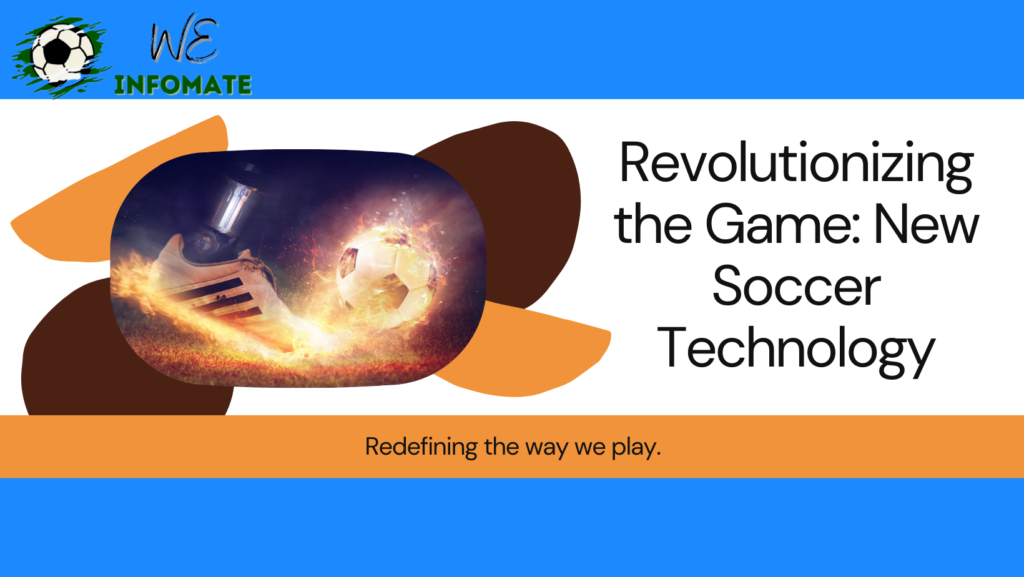The modern soccer game is an ever-changing landscape – one that’s deeply impacted by rapidly evolving technology. Increasingly powerful and capable analytics platforms, AI-driven scouting systems, on-field wearables tracking performance metrics, and more have enabled teams to take a more data-driven approach towards team building and training.
As the capabilities of these technologies increase, they’ve allowed for greater insight into individual player performance as well as helping clubs improve their overall strategy on the field.
In this blog post, we’ll explore how technology has already changed soccer today and what the future might hold for both amateur players and professional footballers alike.

New Technology in Soccer:
An Overview:
The most obvious impact of technology in modern soccer is found in the realm of analytics and scouting. With access to detailed data on player performance, teams can now make more informed decisions about whom they should recruit and how they should train their players. This includes metrics such as running distance, sprint speed, ball touches, pass accuracy, shot accuracy, etc., which are all tracked and monitored through various systems.
AI-driven scouting systems have also revolutionized the way teams scout for potential players. By using algorithms to search for player profiles that match up with a team’s tactical philosophy and playing style, these systems can identify ideal targets much more quickly than traditional methods.
In addition to analytics and scouting, technology has also had a major impact on how the game is played. For example, video assistant referees (VAR) have allowed for more accurate decisions to be made from the touchline, while goal-line technology has ensured that goals are accurately counted and recorded.
Wearable devices such as GPS trackers and heart rate monitors have also become increasingly popular among professional players. These devices help coaches monitor players’ physical condition and performance in real time, enabling them to make more informed decisions on the pitch.
Finally, technology is playing a major role in the fan experience as well. Increasingly sophisticated stadium infrastructure, interactive displays, social media integration, and even 360° virtual replays are just some of the ways that clubs are using technology to better engage with their supporters.

The Future of Technology in Soccer
As technology continues to improve, soccer will likely continue to reap its benefits. One possibility is the use of drones in training drills, as they can provide coaches with a bird’s-eye view of the pitch while also allowing them to track and record players’ movements with greater accuracy.
Augmented reality could also play a major role in the future of soccer. With AR, coaches and players alike will be able to visualize tactical plans in real-time on the field, while fans will be able to get a closer look at what’s happening on the pitch by viewing virtual replays from any angle they choose.
Finally, with the growing popularity of esports and the rise of 5G networks, it’s possible that we could see virtual reality (VR) become a major player in the world of soccer. By combining VR technology with advanced analytics systems, coaches would be able to create fully immersive training environments for their players – allowing them to practice any skill or tactic in a realistic setting.

Benefits of technology in Soccer:
Ultimately, the use of technology in soccer has some major benefits both on and off the pitch. From an analytics perspective, teams can now make better-informed decisions about whom to recruit, how best to train their players, and even which tactics to implement during matches.
On the field, technology has helped referees make more accurate decisions while also improving fan engagement through interactive displays and virtual replays. Finally, wearables have allowed coaches to keep track of their players’ fitness levels in real-time and make the necessary adjustments when needed.
In the future, soccer will only continue to benefit from technology – with ever-improving analytics systems, AI-driven scouting, virtual reality training environments, and more. Ultimately, this could lead to a much more competitive, entertaining, and engaging sport for both players and fans.
From improved player performance to better fan engagement, the role of technology in modern soccer is undeniable. As new technologies continue to emerge, we can expect to see even greater changes take place – revolutionizing how the game is played, coached and watched around the world.
Conclusion:
In conclusion, technology is already having a major impact on modern soccer and it’s only going to become more ingrained in the game as time goes on. As teams continue to take advantage of the data-driven insights that these new technologies offer, they’ll be able to gain a competitive edge – whether it’s on the field or off. With this increased level of sophistication, soccer fans can look forward to an even more exciting and immersive experience in the years to come.
FAQ’S
Q#1) Advantages and Disadvantages of technology in soccer?
Advantages:
The advantages of technology in soccer are numerous. It allows for better scouting and player analysis, more accurate officiating, enhanced fan engagement, and improved training techniques. Players can use wearable technology to monitor their performance and health, while coaches can use data to make strategic decisions.
Disadvantages:
However, there are also some disadvantages. Depending on technology too much can remove the human element from the game and could potentially lead to over-reliance. It can also be expensive, making it less accessible for smaller clubs or teams in developing countries. Moreover, technology like the Video Assistant Referee (VAR) can sometimes disrupt the flow of the game and cause frustration among players and fans alike due to controversial decisions.
Q#2) Technology in Soccer Training?
In recent years, technology has become more widely used in soccer training. Wearable devices such as GPS trackers and heart rate monitors are now commonplace, allowing coaches to monitor players’ physical condition and performance in real-time.
AI-driven scouting systems have also revolutionized the way teams scout for potential players by using algorithms to search for player profiles that match the team’s needs.
Finally, virtual reality (VR) technology is also emerging as a potential tool for training. Coaches can create fully immersive environments in which players can practice any skill or tactic in a realistic setting. This could drastically improve player performance and give teams an edge on the field.



